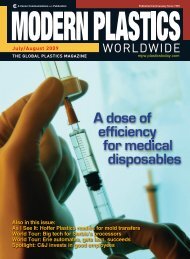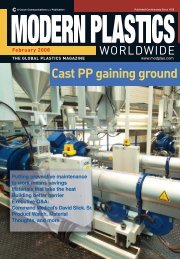amidiq - dae uptlax
amidiq - dae uptlax
amidiq - dae uptlax
Create successful ePaper yourself
Turn your PDF publications into a flip-book with our unique Google optimized e-Paper software.
296<br />
J. Romero-González et al. / Revista Mexicana de Ingeniería Química Vol. 6, No. 3 (2007) 295-300<br />
the biosorbed metal and the bulk concentration of the<br />
metal (Martínez et al., 2000, Altin et al., 1998) This<br />
equilibrium depends on the type of available<br />
functional groups onto the biomaterial, the target<br />
metal and the characteristics of the matrix around the<br />
biosorbent species (Altin et al., 1998, Chojnacka et<br />
al., 2005, Krishna et al., 2000). The biosorption can<br />
be controlled by physical attraction, chemical<br />
complexation with the biomass functional groups,<br />
ion-exchange, or hydrate formation at the surface<br />
(Davis et al., 2003, Demirbas et al., 2005).<br />
The theoretical aspects of the sorption process<br />
have been extensively studied. Adsorption isotherms<br />
have been widely used to model the biosorption<br />
equilibrium, and to predict the binding at different<br />
metal concentrations and environmental conditions<br />
(Altin et al., 1998, Volesky, 2001). The isotherms<br />
also produce many thermodynamic and kinetic<br />
parameters that could be used to better understand<br />
the mechanism involved in the biosorption (Lin and<br />
Juang, 2002, Volesky, 2003). The most common<br />
equations that are used to describe the experimental<br />
isotherm data are the Freundlich and the Langmuir<br />
isotherms, both are non-linear models that suggest<br />
metal monolayer coverage onto the surface of the<br />
biomass (Benhammou et al., 2005, Romero-<br />
Gonzalez et al., 2005a).<br />
The present investigation includes the heavy<br />
metal Pb (II). Similar to other heavy metals, this<br />
metal is released to the environment mainly from<br />
industries, it is not biodegradable, and is<br />
accumulated in living organisms causing diseases,<br />
disorders, and other toxic effects (Fichet et al., 1998,<br />
Volesky, 2001).<br />
Previous studies have shown that similar<br />
biomasses have a high potential for the removal of<br />
cadmium and chromium (III) from aqueous solutions<br />
(Sawalha et al., 2005). Experiments have also shown<br />
that these biomasses have the capacity to adsorb, Pb<br />
(II), from synthetic polluted waters (Contreras et al.,<br />
2005). The current investigation proposes the use of<br />
the biomass produced from the industrial residues<br />
and agricultural waste of Agave tequilana Weber,<br />
commonly known as Agave azul, which is generated<br />
in the production of tequila for the removal of lead as<br />
an alternative in a cost-effective and environmentally<br />
friendly manner. The present manuscript reports on<br />
the Pb (II) biosorption capacity of the Agave azul<br />
leaves biomass.<br />
2. Materials and methods.<br />
2.1. Agave Azul collection<br />
Agave azul (Agave tequilana Weber) leaves<br />
were collected from Centro de Propagación de<br />
Agave del Estado de Guanajuato (CEPAEG) of<br />
Instituto de Ciencias Agrícolas of Universidad de<br />
Guanajuato, with no previous report on metal<br />
contamination. The leaves were cut, washed with tap<br />
water; oven dried at 70°C for 48 h, grounded using a<br />
Wiley-Mill, and sieved to pass through a 100-mesh<br />
(0.149 mm) screen to obtain a uniform particle size.<br />
The leaves were chosen because they represent the<br />
highest percentage of Agave azul plant.<br />
2.2. Metal analyses<br />
A flame atomic absorption spectrometer<br />
(FAAS) (Perkin-Elmer model 3110) was used to<br />
determine Pb (II) in samples. The analytical<br />
wavelength used was 283.3 nm with a slit width of<br />
0.7 nm. The Pb hollow-cathode lamp current was 30<br />
mA. An impact bead was used to improve instrument<br />
sensitivity. Standards were prepared by dilution of a<br />
1000 mg/l stock solution and calibration curves were<br />
obtained using 6 points including the blank. The<br />
coefficients of the used models were computed with<br />
linear least-square fitting. The amount of metal<br />
bound was calculated from the difference between<br />
the amount of metal determined in the corresponding<br />
control solution and the amount of metal in the<br />
solution after treatment with the biomass.<br />
2.3. pH profile studies for metal binding<br />
This experiment was carried out using the pH<br />
profile method previously reported by Gardea-<br />
Torresdey et al. (1998). A 250-mg sample of Agave<br />
azul biomass, previously grounded, was washed four<br />
times with HCl 0.01M, using a centrifuge, to remove<br />
any debris or metals ions from the biomass. The<br />
sample was then washed three times with<br />
deionizated water in order to remove soluble material<br />
or biomolecules that might interact with any sorbed<br />
metal ions. The washed biomass was resuspended in<br />
50 ml of deionizated water to obtain a concentration<br />
of 5 mg of Agave azul per ml of water. The<br />
suspension was adjusted to pH 2 using diluted<br />
solutions of HCl and NaOH. Six aliquots of 4 ml<br />
each of the biomass suspension were placed into six<br />
clean test tubes. The tubes were equilibrated for 60<br />
min and then centrifuged at approximately 3000 rpm<br />
for 5 min (Fisher Scientific Marathon K 8). The<br />
biomass pellets were separated from the supernatants<br />
and saved for the next experiments. 0.1 mM solution<br />
of Pb (II) was prepared from the salt, Pb(NO3)2, and<br />
adjusted to pH 2. Three 4 ml aliquots of Pb (II)<br />
solution were transferred to the test tubes containing<br />
the Agave azul biomass pellets. Three more 4 ml<br />
aliquots were transferred to clean test tubes and set<br />
as control. The tubes were then equilibrated for 1 h<br />
and centrifuged. Similar procedure was followed for<br />
each of the following pH values: 3, 4, 5 and 6. The<br />
final pH of the supernatants was recorded and the<br />
lead content was determined using atomic absorption<br />
spectroscopy. Each experiment was performed in<br />
triplicate for quality control and statistical purposes.









